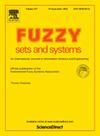有限格上的三角范数
IF 2.7
1区 数学
Q2 COMPUTER SCIENCE, THEORY & METHODS
引用次数: 0
摘要
本文拟在有限格上刻画三角范数。首先给出了原子在完全原子格上生成三角范数的一种方法。然后证明了非布尔原子格上的每个三角模都不是左连续的,TM是原子布尔格上唯一的左连续三角模。进一步,我们证明了每个原子布尔格都可以用具有相同原子数的原子格上的一组三角范数来表示。最后,通过将有限格的扩展原子格上的三角范数限定在有限格上,构造了有限格上的三角范数。本文章由计算机程序翻译,如有差异,请以英文原文为准。
Triangular norms on finite lattices
This article intends to characterize triangular norms on a finite lattice. We first give a method for generating a triangular norm on a complete atomistic lattice by atoms. Then we prove that every triangular norm on a non-Boolean atomistic lattice is not left-continuous and is the unique left-continuous triangular norm on an atomistic Boolean lattice. Furthermore, we show that each atomistic Boolean lattice can be represented by a family of triangular norms on an atomistic lattice with the same number of atoms. Finally, we construct a triangular norm on a finite lattice by restricting a triangular norm on an extended atomistic lattice of the finite lattice to the finite lattice.
求助全文
通过发布文献求助,成功后即可免费获取论文全文。
去求助
来源期刊

Fuzzy Sets and Systems
数学-计算机:理论方法
CiteScore
6.50
自引率
17.90%
发文量
321
审稿时长
6.1 months
期刊介绍:
Since its launching in 1978, the journal Fuzzy Sets and Systems has been devoted to the international advancement of the theory and application of fuzzy sets and systems. The theory of fuzzy sets now encompasses a well organized corpus of basic notions including (and not restricted to) aggregation operations, a generalized theory of relations, specific measures of information content, a calculus of fuzzy numbers. Fuzzy sets are also the cornerstone of a non-additive uncertainty theory, namely possibility theory, and of a versatile tool for both linguistic and numerical modeling: fuzzy rule-based systems. Numerous works now combine fuzzy concepts with other scientific disciplines as well as modern technologies.
In mathematics fuzzy sets have triggered new research topics in connection with category theory, topology, algebra, analysis. Fuzzy sets are also part of a recent trend in the study of generalized measures and integrals, and are combined with statistical methods. Furthermore, fuzzy sets have strong logical underpinnings in the tradition of many-valued logics.
 求助内容:
求助内容: 应助结果提醒方式:
应助结果提醒方式:


